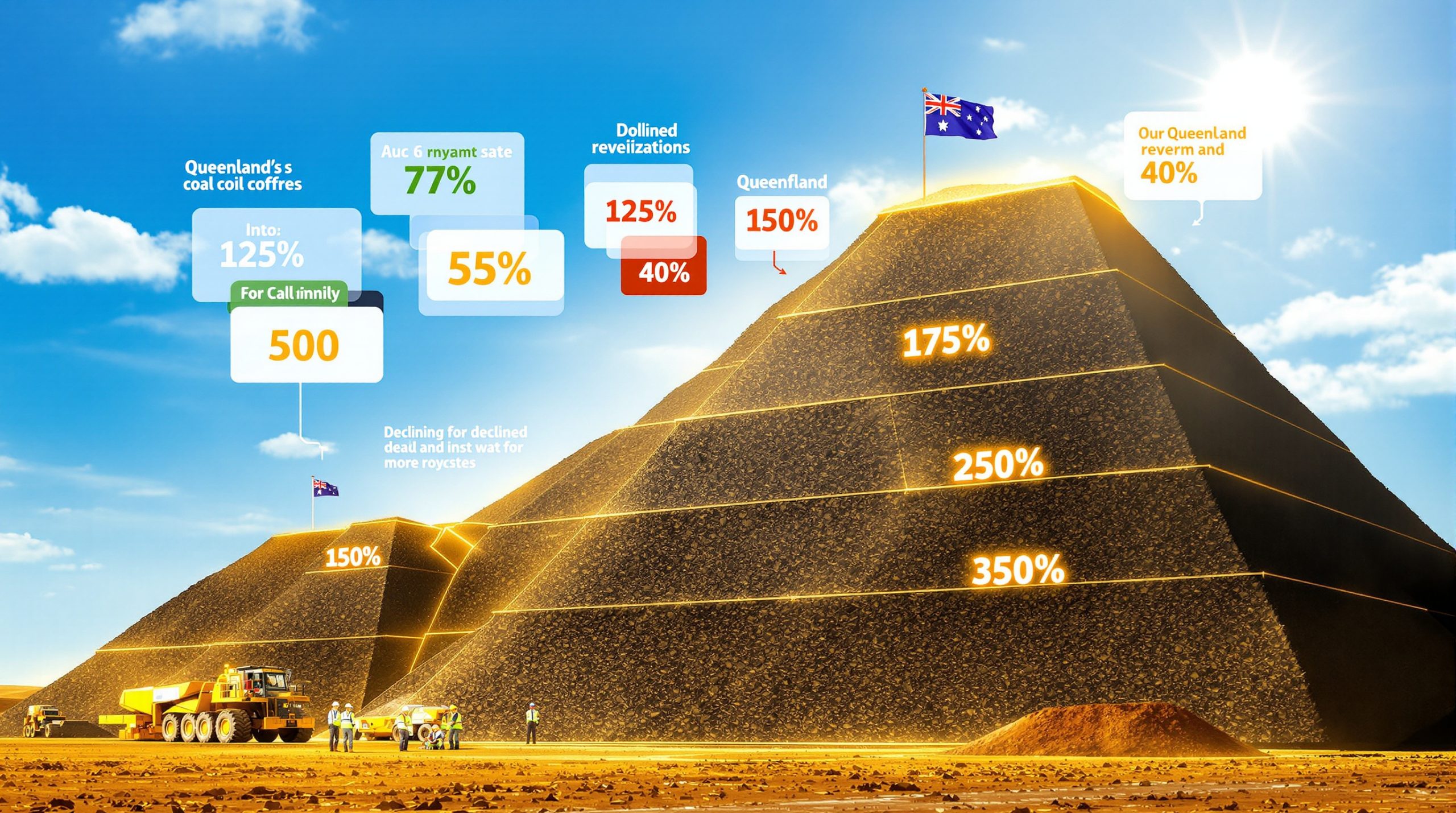How Are Queensland Coal Royalties Affecting Mining Jobs?
The Queensland coal industry is experiencing significant workforce reductions as BHP Mitsubishi Alliance (BMA) announces plans to cut 750 jobs across its operations. This decision comes amid ongoing tensions between mining companies and the state government over coal royalty rates, raising concerns about the long-term sustainability of the sector and its impact on regional communities.
The cuts will affect various aspects of BMA's Queensland operations, from direct mining roles to corporate positions and training facilities. According to ABC News, approximately 72 direct mining roles will be affected at the Saraji South mine, which will be mothballed from November 2025. The majority of the 750 job cuts will come from corporate and support roles across all of BMA's Queensland business, including rail, ports, and coal operations.
Key Impacts of the BMA Job Cuts
The job cuts extend beyond direct mining positions, creating ripple effects throughout BMA's operations:
- 750 total positions eliminated across Queensland operations
- Saraji South mine to be mothballed from November 2025
- 72 direct mining roles affected specifically at Saraji South
- Corporate and support roles comprise the majority of cuts
- FutureFit Academy training facility in Mackay under review
The union reports that the process of reducing the workforce began months ago, suggesting a gradual implementation rather than a sudden announcement. BMA's FutureFit Academy in Mackay, which has trained more than 400 apprentices and trainees since opening, is now under review as the company evaluates its financial viability in the current economic climate.
What Led to BMA's Decision to Cut 750 Jobs?
BMA asset president Adam Lancey attributed the decision to "the combined impact of the Queensland government's unsustainable coal royalties and market conditions." This statement highlights the dual pressures facing the company: regulatory costs and global market challenges.
The Coal Royalty Dispute Explained
At the center of the controversy is Queensland's progressive coal royalty structure, introduced by the former Labor government in 2022. This three-tiered system imposes increasing rates as coal prices rise:
| Coal Price Threshold | Royalty Rate |
|---|---|
| $175 per tonne | 20% |
| $225 per tonne | 30% |
| $300+ per tonne | 40% |
Lancey has consistently maintained that these rates are "unsustainable" because they're applied to revenue rather than profit, creating financial pressure even as operational costs increase. This means that during high-price periods, companies pay substantially more in royalties regardless of their actual profit margins.
The mining industry argues that this structure prevents them from building financial reserves during boom periods to sustain operations when prices inevitably fall. As Lancey explained, "We're losing the good times, then not being able to sustain us through the tougher times."
Market Conditions and Profitability Challenges
Beyond royalties, broader market challenges have contributed to BMA's decision:
- Coal prices have declined significantly from their 2022-2023 peaks when coking coal spot prices reached over $900 per tonne
- BHP reported a 26% slide in full-year earnings in August 2025, with underlying profit dropping to $15.7 billion
- Overall revenue dropped 8% in the most recent reporting period
- The company faced a 44.6% effective tax rate including royalties
- Operational costs continue to rise across the mining sector
BHP announced its lowest full-year earnings in five years last month, reflecting these challenging market conditions. Despite these challenges, the company reported a net operating cash flow of approximately $27 billion, highlighting the complex financial picture behind the job cut decisions.
How Will Regional Communities Be Affected by the Job Cuts?
The job losses will reverberate throughout Central Queensland's mining communities, creating economic and social challenges that extend beyond the directly affected workers.
Impact on Central Queensland Towns
The effects will be particularly felt in communities like Dysart, home to the Saraji South mine, but will extend to surrounding areas:
- Dysart faces direct impact as the host community for Saraji South
- Workers from surrounding towns who commute to BMA sites will lose income
- Small businesses that support mining operations may experience reduced demand
- Potential population decline if workers relocate for employment
- Housing market uncertainty in mining-dependent communities
Federal MP Michelle Landry, whose electorate includes Dysart, highlighted the regional nature of these impacts: "It's not just Dysart that's impacted, it's the whole region that's impacted because people fly-in, they drive in [to work]." She also noted the personal dimension of these job losses: "People might have to move, if they're living in Dysart, looking for other work. There's a big personal cost for the community as well."
Training and Skills Development Setbacks
BMA's review of its FutureFit Academy in Mackay raises concerns about future workforce development:
- The academy has trained over 400 apprentices and trainees since opening
- Current trainees will be supported to find positions within BHP
- Long-term reduction in training opportunities for local youth
- Potential skills shortage when mining activity increases again
- Queensland Deputy Premier called the academy review "un-Australian"
Deputy Premier Jarrod Bleijie criticized BMA's decision to review the training facility, stating: "I think that is unAustralian. I think they should keep investing. They have made billions of dollars from the resources owned by Queensland taxpayers and Queenslanders, and they should keep investing in the future of young people who want a job in a mine or a resources sector in Queensland."
What Is the History of Saraji South Mine Operations?
The Saraji South mine, formerly known as Norwich Park, has experienced multiple operational changes throughout its five-decade history, reflecting the cyclical nature of the coal industry.
Pattern of Operational Changes
The mine has seen several significant transitions:
- Originally opened in 1974 as part of BMA's earliest Queensland operations
- First mothballed in 2012, affecting 400 workers amid falling coal prices
- Reopening plans revealed in 2015, primarily using FIFO workers
- Resumed operations in 2020 as part of the larger Saraji precinct
- Now facing second closure in 13 years, effective November 2025
This pattern of closures and reopenings has created uncertainty for workers and communities. The Mining and Energy Union has criticized BMA for "turning this mine on and off to chase high coal prices with no regard for the community or workforce impact."
When asked if Saraji South might one day be reopened using contract workers instead of full-time staff, Lancey said that was not part of BMA's plan, but if the mine was ever to restart "that will be a decision that will be taken at that time," leaving the door open for potential future operations.
What Are the Political Dimensions of the Coal Royalty Dispute?
The coal royalty issue has become deeply politicized, with different perspectives across Queensland's political spectrum.
Government and Opposition Positions
The debate reveals contrasting views on balancing resource revenue and industry viability:
- Premier David Crisafulli acknowledged worker difficulties but defended maintaining the royalty structure while stating that "the days of the government at war with the industry are over"
- Deputy Premier Jarrod Bleijie emphasized that the government is "approving leases and mining approvals far more efficiently and quicker" while maintaining election commitments not to adjust royalty rates
- Opposition Leader Steven Miles noted that companies didn't close mines when royalties were first introduced and coal prices were higher
- Federal MP Michelle Landry called for the state to cut mining royalties to protect regional jobs
The current LNP government, led by Premier Crisafulli, has committed to maintaining policy stability by not adjusting the royalty regime, a position they took to the election. This leaves BMA and other mining companies operating under the existing royalty structure despite their objections.
Industry Response and Advocacy
The Queensland Resources Council (QRC), whose board president is BMA's Adam Lancey, has consistently opposed the royalty structure:
- Described the rates as "bad policy that costs jobs"
- Advocated for scrapping the 40% top-tier royalty
- Warned of broader industry consolidation concerns
- Highlighted the economic contribution of mining to Queensland
The industry argues that the high royalty rates, particularly the 40% tier, are making Queensland coal less competitive globally and discouraging investment in the state. This position is challenged by opposition figures who point to the industry's profitability during price spikes despite the royalty structure.
How Significant Is BMA to Queensland's Coal Industry?
BHP Mitsubishi Alliance represents a substantial portion of Queensland's coal industry, making its operational decisions particularly impactful for the state's economy.
BMA's Economic Footprint
The company's presence in Queensland is extensive:
- Operates five steel-making coal mines across the Bowen Basin
- Employs approximately 9,500 workers and contractors
- Paid over $4 billion to the Queensland government in FY2024
- Contributed $8.1 billion to suppliers in the same period
- Produces primarily metallurgical coal used in steel production
Saraji is one of five steel-making coal mines owned by BMA in the Bowen Basin, which spans Central Queensland. It is also one of the longest-running, with operations starting more than 50 years ago in 1974.
Recent Asset Changes
BMA has been actively restructuring its Queensland portfolio in recent years:
- Sold Daunia and Blackwater coal mines to Whitehaven for $2 billion in 2023
- Cited dropping profits and higher state royalties as reasons for the sale
- Maintained operations at its five remaining mines
- Continues to be one of Queensland's largest coal producers despite downsizing
These asset changes reflect the company's strategic response to changing market conditions and regulatory environments, as it seeks to optimize its operations in the face of financial pressures.
What Do the Job Cuts Mean for Queensland's Mining Future?
BMA's job cuts are part of a broader trend in Queensland's coal sector, raising questions about the industry's long-term trajectory.
Broader Industry Trends
The challenges facing BMA reflect wider issues in the coal mining sector:
- Total job losses in Queensland coal mining exceed 900 in 2025 when combined with cuts from other miners
- Anglo American and mid-tier companies like QCoal have also reduced workforces
- Industry describes itself as approaching a "crisis point"
- Questions arise about long-term investment in Queensland mining
- Tension between royalty revenue needs and industry sustainability
According to Adam Lancey, "The simple fact is the Queensland coal industry is approaching a crisis point. This is now having real impacts on regional jobs, communities and small businesses."
The Economic Balancing Act
The situation highlights the complex balance between:
- State revenue needs funded by resource royalties
- Employment stability in regional communities
- Long-term investment in Queensland's resources sector
- Global market competitiveness for Australian coal
- Transition planning for communities dependent on mining
Queensland's coal royalties contributed approximately $9 billion to the state's budget in FY2022-23 during peak coal prices, representing about 13% of total revenue. This significant contribution makes finding the right balance between industry viability and public revenue particularly challenging.
How Are Unions Responding to the Job Cuts?
Union representatives have strongly criticized BMA's decision, questioning both the timing and justification for the cuts.
Worker Representation and Criticism
The Mining and Energy Union has taken a firm stance on BMA's decision:
- Accused BMA of using workers as "pawns" in its fight with the government over royalties
- Criticized the company for "spreading fear through the media"
- Called for proper consultation with affected workers
- Claimed BMA is "sulking" after making enormous profits during coal price spikes
- Noted that even with higher royalties, BHP profited significantly when prices peaked at over $900 per tonne
Mining and Energy Union president Mitch Hughes stated that "BHP should stop using coal workers and communities as pawns in its fight with the Queensland government over royalties. Workers need facts, certainty and security — not alarmism."
The union also described the company's blaming of royalties as "disingenuous," with Hughes adding: "It's very disappointing to see BHP close a mine as soon as coal prices come off the boil. But they have form in turning this mine on and off to chase high coal prices with no regard for the community or workforce impact."
Worker Support and Transition Assistance
Unions are advocating for:
- Transparent communication about job impacts
- Redeployment opportunities within BHP where possible
- Adequate severance packages for affected workers
- Skills transition support for those leaving the industry
- Government assistance programs for affected communities
Queensland Opposition Leader Steven Miles called on the government to "do whatever they can to either support BHP to keep these jobs or to help those workers into other jobs," highlighting the need for coordinated worker support strategies for affected employees.
What's Next for Queensland's Coal Industry?
The coal industry in Queensland faces several critical questions about its future trajectory and sustainability.
Future Outlook and Considerations
Several factors will shape the industry's path forward:
- Global coal demand trends, particularly for metallurgical coal used in steelmaking
- Potential technological changes in steel production that could affect coal demand
- Queensland government policy decisions regarding royalties and mining approvals
- Mining companies' investment strategies and operational choices
- Community transition planning for mining-dependent regions
The resolution of tensions between industry viability concerns and the state's revenue needs will play a crucial role in determining the industry's future direction.
Potential Scenarios
Several possible outcomes could emerge:
- Status quo maintenance: Government maintains current royalty rates while companies continue operational adjustments, potentially including further job cuts and mine closures
- Royalty reform: Potential future modifications to the royalty structure to address industry concerns about competitiveness
- Further industry consolidation: More mergers, acquisitions, and mine closures as companies seek economies of scale
- Technological transformation: Accelerated automation to reduce operational costs and workforce requirements
- Diversification initiatives: Government and industry programs to support regional economic diversification beyond coal mining
Each scenario presents different implications for workers, communities, companies, and the state government, highlighting the complex interplay of interests involved in Queensland's coal industry. Furthermore, understanding the industry evolution trends and broader mining industry trends will be crucial for navigating this challenging landscape within the broader global mining landscape.
FAQ: Queensland Coal Royalties and Mining Jobs
How do Queensland's coal royalties compare to other mining jurisdictions?
Queensland's progressive royalty structure with rates up to 40% is among the highest in Australia. Other states typically have lower maximum rates, with New South Wales capping metallurgical coal royalties at 8.2% and thermal coal at 7.2%. Internationally, major coal producers like Indonesia (13.5%) and South Africa (variable but generally lower) also maintain more modest royalty structures.
Why doesn't the Queensland government reduce royalties to protect jobs?
The government maintains that the royalty structure is appropriate because it allows the state to benefit when coal prices are high while providing lower rates during market downturns. The revenue funds essential public services including healthcare, education, and infrastructure. The current government has committed to maintaining policy stability for investment certainty.
Will the Saraji South mine ever reopen?
Based on historical patterns, reopening remains possible if market conditions improve significantly. The mine has previously been mothballed and restarted. However, BMA has not provided specific criteria or timelines for potential reopening, describing the closure as "care and maintenance" rather than permanent shutdown.
How much do coal royalties contribute to Queensland's budget?
Coal royalties have been a significant revenue source, contributing approximately $9 billion to Queensland's budget in FY2022-23 during peak coal prices. This represented about 13% of the state's total revenue that year. The contribution fluctuates with coal prices and production volumes.
What support is available for affected workers?
Affected workers may access various support mechanisms including:
- Potential redeployment to other BMA operations
- Severance packages based on years of service
- Government employment services and job matching
- Skills transition programs for those seeking to change industries
- Financial counseling and support services
Ready to Capitalise on the Next Major Mining Discovery?
Stay ahead of market-moving announcements with Discovery Alert's proprietary Discovery IQ model, delivering instant notifications of significant ASX mineral discoveries straight to your inbox. Visit our discoveries page to understand how historic mineral discoveries have generated substantial returns for early investors.




